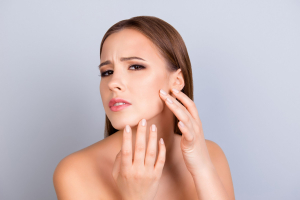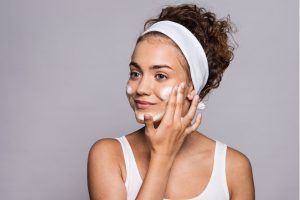Notice that your upper lip still looks dark after waxing, threading, or other hair removal treatments? It’s not hair, it’s a melasma mustache. Almost half of all women will experience melasma at some point in their life—most often on their face. It’s one of those things we don’t talk enough about, but we should be!
What Is Melasma?
Also referred to as hyperpigmentation, pigmentation, skin discoloration, or plain old dark spots—melasma refers to anything that causes darker skin on your face or body. Depending on your skin tone, melasma may present as light brown, dark brown, or blue-grey.
Melasma is caused by the overproduction of melanin. Melanin is the substance that produces your unique hair, eye, and skin color. If your body is triggered for any reason to produce more melanin a dark spot will form. This could be anything from a tiny freckle to large patches. On your upper lip, it’s often a series of tiny spots that are barely noticeable individually, but visible with their proximity to one another.

What Are The Different Types of Melasma?
One of the most frustrating things about hyperpigmentation is that it seemingly pops up out of nowhere. Knowledge is power, so learning the top causes empowers you to take a proactive approach.
Hormonal Changes
Over 90% of those diagnosed with melasma are women. This is because fluctuating estrogen levels can increase melanin production. Many women first experience skin discoloration when they start taking birth control, while pregnant, or as their hormones begin to fluctuate during perimenopause. During pregnancy, melasma is often referred to as the “mask of pregnancy” or chloasma.
UV and Sun Exposure
One of many reasons to wear broad-spectrum UV protection every day (even in the winter) is to minimize your risk of melasma mustache or pigmentation anywhere your skin is regularly exposed. UV exposure, including the blue light of electronic devices, accelerates melanin production. This can lead to what we often refer to as sunspots, liver spots, and brown spots. Over 90 percent of adults over the age of 50 have at least one sunspot.
Acne and Scarring
There’s no avoiding post-inflammatory hyperpigmentation. When you have acne or a cut, scrape, burn, or other injury your skin is likely to scar. Your body is intelligent and heals naturally. During the healing process your skin creates more melanin where the skin injury has occurred. This is the one type of melasma that is likely to fade without targeted treatment, but faster with targeted treatment.

Does Melasma Hurt?
No. Unless your skin is still healing from acne or an abrasion, the darker patch of skin should be 100% pain-free. If you have an itchy, red, or irritated mole or dark spot—seek immediate medical attention.
Although pigmented skin doesn’t hurt, it can leave you feeling self-conscious about your appearance. Especially when it forms on your face or neck.
Why Is Melasma More Common On The Face?
You’re most likely to experience darker patches of skin in areas regularly exposed to direct sunlight. Your face comes in direct contact with the sun every day, which is why pigmented skin is most common on the face.

How to Treat Your Melasma Mustache?
Now that you know what a melasma mustache is, let’s dive into some of your treatment options. This includes what to do, what not to do, and how to take an approach that is both proactive and reactive.

#1 Don’t Purchase Skin Bleaching Products
If the discoloration on your upper lip, face, or body leaves you feeling self-conscious, you’re likely searching for the fastest resolution. When you head online, you’re sure to find a range of skin bleaching and skin-lightening products that promise rapid results. These products are highly toxic, often containing mercury, hydroquinone, and other toxins that are banned for skincare use in many countries. They’re also more likely to irritate and harm your skin.
The options below are effective and don’t risk your health.
#2 Conceal Your Dark Spots
The fastest and easiest thing you can do is switch your foundation to a color-correcting cream (CC cream). CC creams are formulated specifically for masking melasma and evening out skin tone.
If you prefer lighter coverage, select a foundation or powder with light-reflecting particles. These are often referred to as “photo-ready” products. Their light shimmer minimizes your discoloration.

#3 Explore Non-Bleach Dark Spot Treatments
There are a variety of over-the-counter skincare products designed to address dark spots that don’t contain harsh or toxic chemicals. They’re often labeled “skin brightening” or “dark spot correctors”. Most of these formulas contain one or both niacinamide or Vitamin C.
- Niacinamide: Also known as vitamin B3, applying niacinamide topically has been proven to fade dark spots when used twice daily for 2 months. However, results don’t improve past the 2 month point. Topical niacinamide is safe for sensitive skin and provides a variety of skincare benefits—including shrinking your pores!
- Vitamin C: Vitamin C is a powerful antioxidant that should be part of every anti-aging skincare routine. When speaking of your melasma mustache, vitamin C contains an enzyme that fades scars and proactively slows down the overproduction of melanin. If your skin is sensitive, ensure that the product you use has a maximum of 10% concentration. Products with 15% or 20% concentration may irritate your skin.
#4 Seek Professional Help
For a personalized approach, schedule an appointment with a dermatologist or medical spa. They will assess your skin, determine the cause of your facial pigmentation, and provide you with targeted treatment options. The darker your melasma, the more likely you’ll need professional treatment.
This might include:
- Prescription medications: A dermatologist may prescribe retinoids or suggest non-prescription skincare products. Prescription retinoids are much stronger than what you can purchase online or over the counter. They will also suggest ways to personalize your skincare routine.
- Aesthetic treatments: There are a variety of non-invasive and minimally invasive aesthetic treatments that fade scars and even out skin tone. From microdermabrasion to intense light pulse therapy (IPL), or a non-invasive radiofrequency treatment.
#5 Apply Broad-Spectrum UV Protection Daily
We touched on this above, but UV exposure accelerates melanin production, increasing your odds of melasma. So, apply a broad-spectrum sunscreen of a minimum of 50 all year round. Broad-spectrum differs from SPF protection, as it blocks all potentially harmful rays—including the blue light of electronic devices and light bulbs.
When it comes to filtering UV rays, think beyond sunscreen. Many daytime moisturizers, foundations, and powders have UV protection built in. Be sure to reapply every 2 hours when outdoors and every 4 hours when indoors.
Say Goodbye to Your Melasma Mustache!
The sooner you begin melasma treatment the better as the dark spots on your body and upper lip can get darker over time.
[wp-faq-schema title=”Frequently Asked Questions”]

